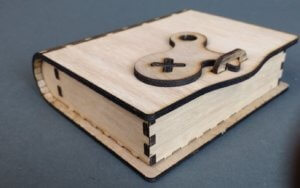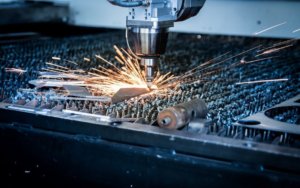Why Laser Cutter Maintenance Matters
Maintenance plays an important role in keeping almost anything working properly. It’s how to prevent things from breaking and needing repairs. Think about all the items that require regular maintenance: appliances, cars, houses, etc. Even our bodies need maintenance to keep working properly. Car owners know to get regular oil changes to prevent engine problems. Healthy people know to exercise and eat well to stay in good shape. Even kids have a general understanding of maintenance because they need to take care of their toys so they don’t break.
Laser cutters aren’t any different. They are machines with lots of working parts, such as lenses, mirrors, and filters, and each part needs to be in good shape for your machine to work well. Without proper maintenance, your laser cutter may not function properly or could completely stop working.
Consider the disappointment in designing a project with your laser cutter, only to discover it isn’t able to complete the task you want. A few minutes of maintenance could save you from costly, time-consuming, and frustrating repairs.
Benefits of Maintaining Your Laser Cutter

A. Last Longer
The more you know about how to maintain a laser cutter, the longer life you’ll get out of it. That’s because you’ll prevent issues with parts and performance by keeping the laser cutter in optimal condition. Parts won’t wear down and become less effective. You’ll get the most use out of your machine.
B. Save Money
Because your laser cutter is an investment, it isn’t very cost-effective to just buy a new one if your current one breaks. Even replacement parts could impact your budget. It would be a lot more fun to spend money on materials for your laser cutter projects than it would be to constantly replace new parts.
C. Perform Better
There are a lot of uses for a laser cutter, from education to hobbies to functional design work. No matter the intended purpose, you’ll want your laser cutter to work efficiently and precisely so you can create fun and useful items. Laser cutter maintenance can help guarantee that your device can make exactly what you’re looking for without flaws and frustrations.
General Laser Cutter Maintenance
Maintaining your laser cutter isn’t difficult or time-consuming. Most maintenance depends on how often you use your cutter. Remember, it’s important to keep it in good condition!
A universal suggestion about maintenance is to always be present when using your laser cutter so you’ll notice any issues right away and can immediately perform necessary maintenance before there are issues. Additionally, anytime you’re removing a part for maintenance, you should do a general check of the revealed parts of the laser cutter.
The most frequent maintenance task is cleaning the laser cutter’s lens and mirror. You should do this daily (or after about eight hours of use). A lot of dust and debris from cutting can settle on this part, and without proper cleaning, you risk the laser cutter not working properly or permanent damage to the lens and mirror.
Some laser cutters have filters, charcoal, and dust traps. After the equivalent of a week of use, you’ll need to replace any pre-filter and clean out your laser cutter’s dust trap. You’ll know this maintenance is due when you see smoke collecting in the laser bay, notice flames or sparks during cutting, smell more odor than usual, or see that the filter is dirty. If your laser cutter has charcoal to help with the fumes produced during cutting, specifically plastics, then you’ll need to replace the charcoal every six to twelve months. The final bit of laser cutter maintenance is replacing the HEPA filter. You should do this annually. It’s the most expensive bit of maintenance, but performing all of the other tasks regularly can help maximize the life of your HEPA filter so you don’t have to replace it too often.
There is also specific co2 laser cutter maintenance. You’ll need to keep an eye on the carbon dioxide, helium, and nitrogen levels and replace the bottle if they get too low. Additionally, make sure the water in the cooling system has the proper proportion of chemicals. Check and clean any parts as you perform the needed maintenance.
Using Laserbox

If you’re looking to purchase a laser cutter, the Makeblock Laserbox is a great option. It is versatile and can fit on your desktop for easy use. Like other Makeblock products, the Laserbox is designed for education and creating.
A. Easy to Use Features
The Laserbox laser cutter has many features that make it easy to use. It is able to cut various materials, including paper, wood, acrylic, leather, cloth, PET, rubber, glass fiber, plastic, and more. Its versatility makes it easier for you to complete any of the projects you can imagine.
The laser box also has the ability to cut patterns hand-drawn on the material. The AI visual algorithm automatically identifies and programs the laser cutting path without complicated programming.
Additional features of the Laserbox laser cutter include autofocusing so you don’t have to manually adjust the laser head. You can also preview your designs and check the laser cutter’s progress in real-time.
B. Full Support Available
The Laserbox comes with a full suite of lessons to help users with personal and classroom applications. A gallery provides access to available projects. Makeblock also has complete product support for the Laserbox, including documentation, FAQs, warranty information, and daily maintenance videos.
Makeblock Laserbox Maintenance Tips

Makeblock recommends six maintenance tasks. Below is an overview of the detailed support videos available online for Makeblock Laserbox maintenance.
1. Perform a position calibration on your laser cutter: First, lift the cover and clean the camera with alcohol. Connect the laser cutter to your computer and select “calibrate” from the menu. Glue three pieces of paper to the honeycomb board as displayed and then run the calibration.
2. Clean the air nozzle and laser head on your laser cutter: Disassemble the Z-axis top and front cases and scrub the laser head with alcohol on a dustless cloth. Hold the plastic air nozzle plug and pull out the air pipe. Clamp the air nozzle outlet with pliers and rotate it in a counterclockwise direction. Clean the metal plug with a toothpick or tweezers, and use the provided tool to clean the nozzle and wipe it with alcohol. Reassemble the parts.
3. Maintain the rails on your laser cutter: Use alcohol and the dustless cloth to clean the X and Y guide rails. Remove the Z-axis front case with a screwdriver and rotate the motor in a clockwise direction so you can access the guide rail to clean and lubricate it. Reassemble parts to the Z-axis and lubricate the X and Y guide rails.
4. Change the water on your laser cutter: Use a heat gun or hair dryer to heat the right lens of the machine so you can remove it. Use a water pipe to remove water from the reservoir into a container. Use a funnel to pour purified water into the tank and let the machine run a water cycle. Repeat. Make the anti-freezing solution, stir, and let it sit. Use a funnel to pour the solution into the water reservoir to the level line. Turn on the machine, let the water run into the machine, and fill the reservoir back to the level line. Adhere to the decorative lens cover back on the machine.
5. Clean the lenses on your laser cutter: Pull out the X-axis to access the first mirror and take it out. Use alcohol and the dustless cloth to clean the mirror in a clockwise direction being careful not to touch it with your hand. Reassemble the mirror. Repeat the process for the remaining mirrors, crescent focus lens, and laser head.
6. Replace the laser tube on your laser cutter: Disassemble the laser tube cover by removing the screws. Slide the cover out and remove the clamps. When disassembling the laser tube remember that it is polarized with the negative pole on the left and positive on the right. We recommend following the video for the specific, detailed steps for the laser tube.
It’s important to know how to maintain a laser cutter. You’ll save costs and have a machine that lasts longer and performs better. You’ll be able to make the most out of your 3D laser cutting machine, like the Makeblock Laserbox.